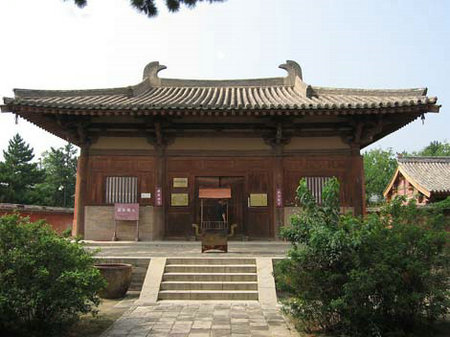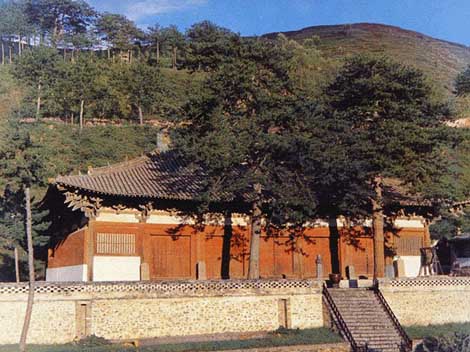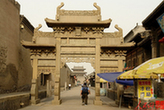Chinese architecture constitutes the only system based mainly on wooden structures of unique charming appearance. This differs from all other architectural systems in the world which are based mainly on brick and stone structures.
There are four extant wooden structures of the Tang Dynasty (618-907), all of them being Buddhist halls in Shanxi. They are very valuable; especially important are the two big halls -- Nanchan Temple and Foguang Temple.
 |
Nanchan Temple |
Located in the southwest of Wutai Mountains, the Nanchan Temple, built in the 3rd year (782) during the reign of Tang Emperor Jianzhong, is a very small hall, its plane close to a square shape. Because it is in great depth, the roof is of a single-eaved Xieshan type (two slopes on the upper part and four slopes on the lower). The slope of the hall is very gentle. Because the plane is close to a square, if the Chinese hipped roof (four slopes on the lower part) is adopted, the front ridge will appear to be too short, and the structure will be very complicated. If Xieshan is adopted, the proportions will be very suitable. Later, this became the method generally adopted for halls of a square or close to a square plane.
 |
Foguang Temple |
Located in Doucun Village at the foot of Wutai Mountains, the Foguang Temple, founded in the 11th year (857) of Tang Emperor Dazhong, is a medium-sized hall standing on the terrace at the back of the temple.
The plane of the big hall is of rectangular shape. It consists of seven rooms in the front, with a circle of inner pillars within the hall dividing it into the heart and the surrounding two parts. In the heart is a Buddhist altar on which there are five groups of statues in tacit coordination with buildings. The roof is single-eaved Wudian, the slope of the house is also gentle.
The composition of the space represents a major characteristic distinguishing architectural art from other plastic arts. The hall of Foguang Temple provides us with the only important example for understanding the internal space of Tang Dynasty structures. The core space is fairly high. The walls and Buddhist altar between pillars also give prominence to its important position. Around the check-shaped ceilings are slanting rafters, under which are thoroughly exposed beam frames. These beam frames are both necessary structural members and an important means of expressing the structural beauty and dividing the space. Between the wooden structural members of the beam is vacuum .The space between makes "circulation" possible, which is empty, bright and permeable. The grandiose beam frame and the dense checks of the ceilings form the contrast between the coarse and the fine, and the sense of weight. The low and narrow peripheral space serves as a foil to the center space. But the designing methods for the beam frame and the ceiling are identical. The entirety is accomplished at one stretch giving a strong sense of order. All spaces of different sizes try hard to avoid complete isolation in terms of horizontal and vertical directions. The complex and interwoven beam frame, in particular, makes the boundary surface of the space hazy and implicit, without the least sense of rigidity and stagnation.
This example demonstrates that artisans of Tang Dynasty architecture already had a high degree of self-conscious spatial esthetic judgment and superb spatial handling technique.
Editor: MetalAllen





Why not rent a boyfriend, or girlfriend to please parents during the Spring Festival?